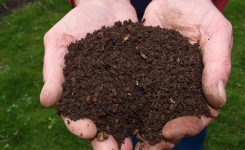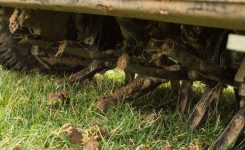Lawn Care Services, Lawn Treatment Solutions Blog
Should I Seed Bare Areas in My Bermudagrass Lawn?
Should I Seed the Bare Aeras in My Bermudagrass Lawn?
Most Bermudagrass lawns have areas that are thin or bare, and naturally Crownover Green clients want to know if they should overseed or spot seed to make these areas thick and healthy like the rest of their lawn.
Before you decide if you should seed the bare or thin areas in our Bermudagrass lawn, you should first determine if your grass has adequate sunlight.
Often, the reason Bermudagrass becomes thin or bare is due to inadequate sunlight. Bermudagrass needs at least eight hours of direct, unfiltered sunlight to grow thick. If inadequate sunlight is what is causing the bare or thin spots, then trying to establish new Bermudagrass in the thin or bare area is not a good solution.
Options for Inadequate Sunlight
Consider non-lawn features such as shade tolerant shrubs, perennial flowers, or ground covers along foundations, fences, and natural areas, or under the branches of trees in your yard if the thin or bare spots are due to inadequate sunlight.
For larger areas where you would like to have a lawn, you can choose a different type of grass. Centipedegrass and Zoysiagrass may do okay with 6-7 hours of sunlight. Tall Fescue does well with 5-6 hours of direct sunlight, but it is a cool-season plant that will not match your Bermudagrass well. Fine Fescues are known to survive with as little as 3-5 hours of full sun, but are generally not as heat tolerant as Tall Fescue (and they won’t match your Bermudagrass well, either).
Options if There’s Adequate Sunlight
If there is adequate sunlight then you have a couple of options for improving your lawn, but seeding is probably not one of them.
Here’s why.
Most Bermudagrass that is installed in the Wake Forest/Rolesville area is a hybrid Bermudagrass that cannot reproduce from seeds. Hybrids do produce seeds in the spring but their seeds are sterile. Hybrids reproduce vegetatively, meaning they spread naturally.
The type of Bermudagrass that grows from seeds is called a common Bermudagrass. “Common” refers to a horticultural classification rather than how widespread or ordinary this type of Bermudagrass is. In fact, hybrids are much more widespread in the Wake Forest/Rolesville area than commons. Fewer than 5% of Crownover Green clients with Bermudagrass lawns have a common type. The rest are hybrids.
A common Bermudagrass overseeded into a hybrid Bermudagrass lawn tends to look weedy, which is why we do not recommend doing it.
There is a noticeable difference in appearance between the two types. Common varieties have a wider blade, coarser stem, faster growth rate, different green-up period, and/or slightly different color than hybrid varieties.
If you have bare or thin areas in your hybrid Bermudagrass, then seeding them is not the best solution unless you don’t mind that the new grass will not match the rest of your lawn.
Bermudagrasses will spread aggressively given proper care and at least eight hours of direct, unfiltered sunlight per day. Fertilization, irrigation, and a little patience while the grass spreads throughout the summer is all that is needed.
Small spots that are a foot or two in diameter will fill in within one summer. Very large bare spots may take a couple of growing seasons to fill in.
If you are looking for a quicker fix for bare spots in your hybrid Bermudagrass then sod is your best option. If you are a DIYer, Hybrid Bermudagrass can be purchased by the piece at big box garden centers during the summer in the Wake Forest/Rolesville area, or you could contact a pro to help you.
To sum it up, if you don’t have adequate sunlight for Bermudagrass, you’ll want to explore a non-Bermudagrass option for the thin or bare spots. If you have adequate sunlight for Bermudagrass, patience will take care of it as the grass will spread and will fill in the thin or bare spots. If a quick fix is in order, sod is a great option.
To learn more about why your Bermudagrass lawn may be thin in some places, read our blog article:
https://crownovergreen.com/2020/04/why-is-my-bermudagrass-thin-in-some-places/








